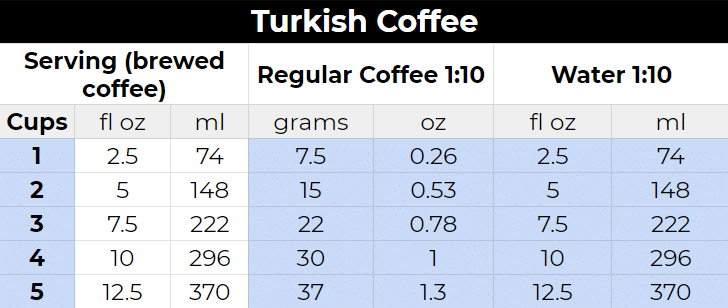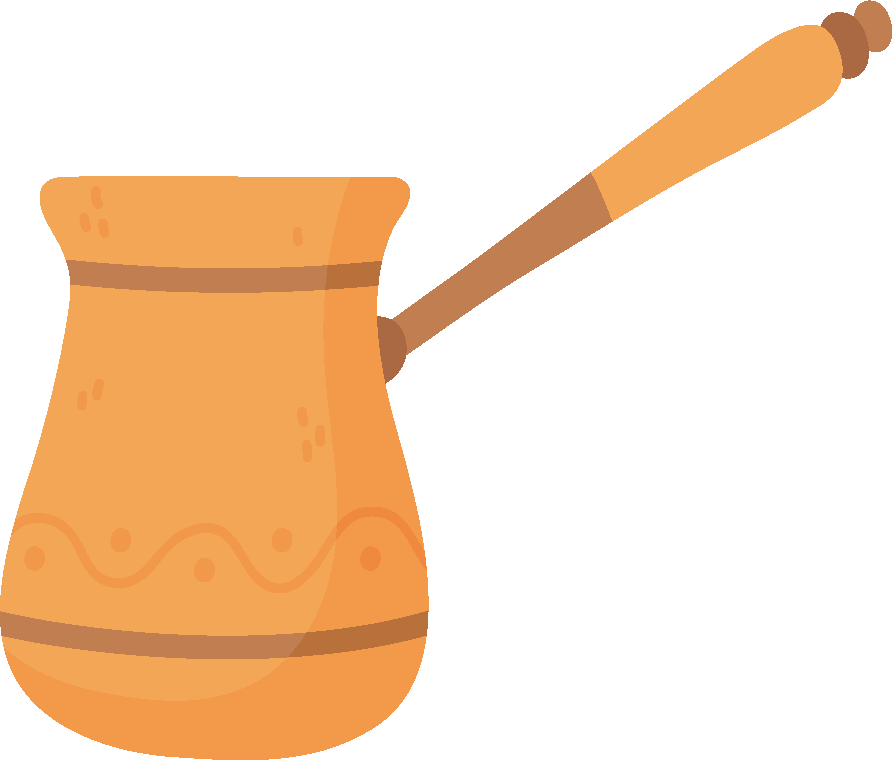If you want to know how to make Turkish coffee the right way, then you are in the right place.
Turkish coffee has been around since the 16th century. It's one of the first brewing methods with a deep history and rich culture.
Turkish coffee is popular all over the world, but it is most widespread in the Middle East, North Africa, the Caucasus, the Balkans, and other territories that were once part of the Ottoman Empire. Turkish coffee was the main brewing method used by the Ottomans.
"Turkish" coffee is a European and American name. In the Middle East, a coffee prepared this way is simply called "coffee."
Traditional Turkish coffee is made in a small, long-handled pot called a cezve or ibrik. The middle eastern coffee is very dense and strong because no filter is used, because small coffee particles remain in the finished Turkish coffee, and because it is brewed for a long time at a high temperature.
How to Make Turkish Coffee in a Cezve
If you want to get visual information on how to make Turkish coffee, then check out this video on YouTube:
If you want to read and make Turkish coffee right away, here's our step-by-step guide:
Step-by-Step Instructions on How to Make Turkish Coffee
First, let's talk about what you need before brewing:
- Pure drinking water (total mineralization 50-150 ppm, room temperature)
- Coffee grinder with the ability to do a fine grind like a cocoa powder. Visually, it should look like extra-fine salt. For dark roasts, you can use a slightly larger grind.
- Scale
- Cezve
- Freshly roasted coffee beans
Step-by-step instructions of how to make Turkish coffee are described in the section below.
How to Make Turkish Coffee
1. Choose your favorite freshly roasted coffee.
2. Measure enough beans for a 1:9 ratio.
3. In the cezve, mix water, coffee, and sugar (if you like). Stir.
4. Place the cezve on an open fire and make sure the surface of the drink is foaming but not boiling.
5. As soon as you see foam, remove from heat. Take off some foam and put it in a cup.
6. Let the cezve rest for 20 seconds, then put it back on fire.
7. As soon as it starts to foam again, remove and let stand for 20 seconds.
8. Put it on the fire one last time and keep it there until it foams again.
9. The coffee is ready, so pour it gently into your cup.
Tips
Experiment with more or less coffee grounds to get the strength and flavor you want.You can always vary the taste of the coffee with spices and herbs.
Grind size: Extra fine
Brew ratio: 1:9
Extraction time: 4 min
Tips For Making Turkish Coffee
Grinding and Dosage
For Turkish coffee, use a fine grind. It should feel like dust or powder. It is because of this that the cezve is the only brewing method for which you can use a blade grinder.
The dosage of coffee depends on the size of the cezve. To determine the dosage, you need to measure how much water can be placed in the cezve under the place where the neck begins to narrow.
For example, if your cezve claims its volume is 7 fl oz (210 ml), then 5 fl oz (150 ml) of water is recommended.
Coffee-to-Water Ratio
The normal ratio of coffee to water for Turkish coffee is 1:10. That is, for 5 fl oz (150 ml) of water, you need 0.52 oz (15 g) of coffee.

Equipment
To make coffee in a cezve, you need a good burr coffee grinder that is capable of fine grinding. But you can also use a blade grinder.
In addition to a coffee grinder, you need room-temperature water with low mineralization (50–150 mg/L), freshly roasted coffee beans, a stirring spoon, and the cezve itself. We recommend a copper or ceramic cezve.
Copper cezve are used in Turkey. It is important that the copper cezve has an inner lining of silver or food-grade tin. The vessel has a wide base, tapers towards the top, and has a spout.
The diameter of the neck should be 15-20% less than the diameter of the base if the cezve is of standard geometry (the taper is closer to the top). This is important for the coffee foam to form.
!
Cezves come in a variety of sizes, from small (1 cup) to large (6 or even 8 cups), but it is best not to use a cezve over 10 fl oz (300 ml). In a big cezve, the coffee will be under-extracted.
In addition, it's important to choose a cezve that has enough free space (but not too much) after you add water. When brewing, the coffee will rise in the cezve and form a foam. If there is too much space in the cezve, the foam can burn to the edges and impart unwanted bitterness.
When brewed correctly in a cezve, Turkish coffee is very rich and thick.
!
Here's a very important tip: never take your eyes off the coffee when brewing it in cezve. It can boil over in a matter of seconds.
If you want to add flavor to your traditional Turkish coffee, you can add sugar and spices such as cardamom, cinnamon, or anise to the cezve. In any case, follow this rule: add loose ingredients (spices or sugar) to ground coffee and liquid ingredients (syrup) to already-brewed coffee.
What Is the Best Type of Coffee to Use in a Cezve?
Any type. The choice of coffee beans is a matter of taste. Don't be afraid to try a robusta blend—these work well in a cezve. You can use any roast you like—light, medium, or dark.
There is some debate over whether or not to stir the coffee while brewing in a cezve. Stirring coffee after it's removed from the heat will result in a much cleaner cup as the grounds present in the foam will settle to the bottom.
However, advocates of not stirring the coffee while brewing argue that an equal amount of foam should go into each cup. To stir or not is a matter of preference, but in any case, stirring should only be done once the coffee has been removed from the heat.

